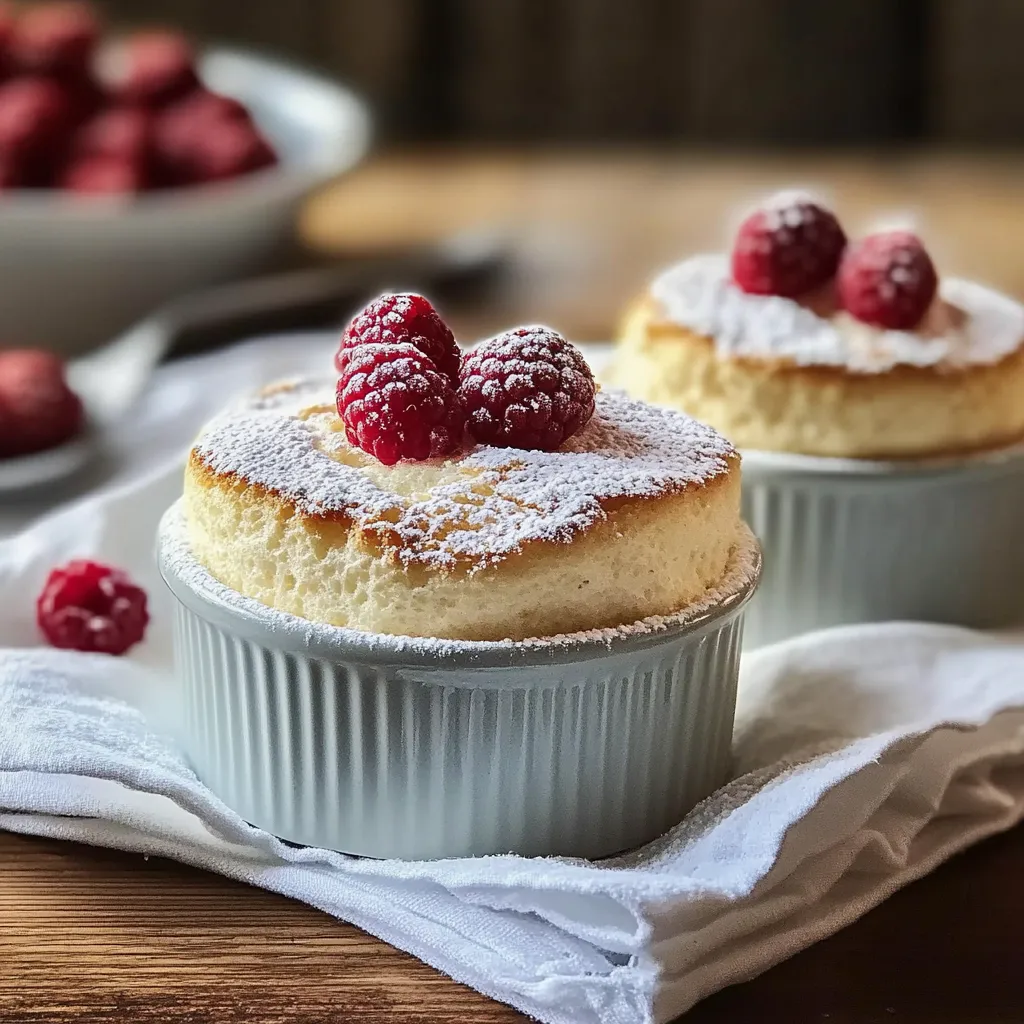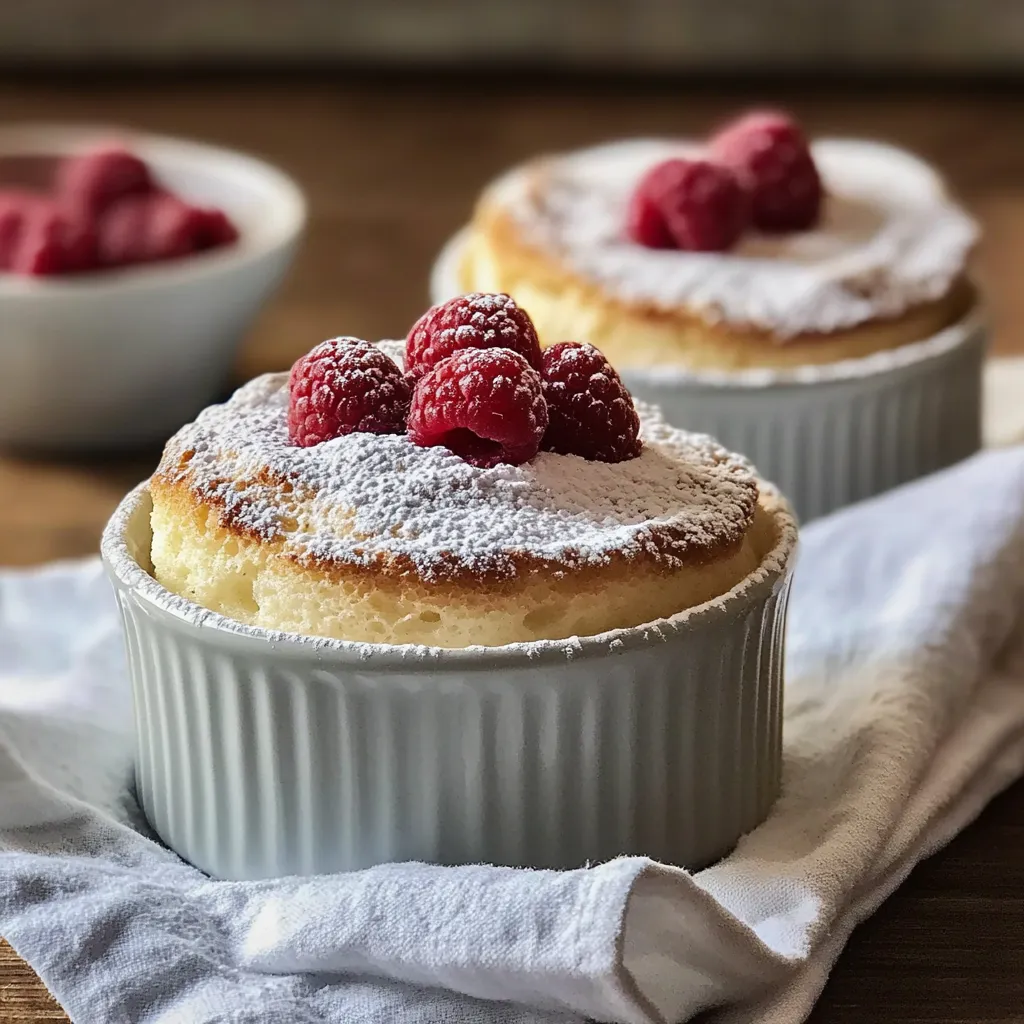 Pin it
Pin it
Fluffy Vanilla Soufflé transforms simple ingredients into an ethereal cloud of delicate sweetness that rises majestically above its dish. This classic French dessert embodies culinary alchemy at its finest—egg whites whipped to peaks, gently folded into a vanilla-scented base, then baked until they dramatically ascend into a golden, trembling dome. Each spoonful offers a textural experience unlike any other dessert: a crisp, sugar-dusted exterior giving way to a warm, impossibly light interior that seems to dissolve on your tongue. Far more than just a recipe, a successful soufflé is a moment to be savored immediately, a fleeting masterpiece that captures the essence of elegant simplicity.
I first attempted making soufflés during a particularly challenging time in my life, when focusing on precise techniques provided a welcome respite from worry. The transformation that occurred in my oven felt almost magical—watching something so delicate rise so dramatically gave me a sense of accomplishment I desperately needed. Now, whenever I make this dessert for friends, I'm reminded of how even the simplest ingredients can rise above expectations when treated with care, patience, and attention to detail.
Perfect Ingredients
- Unsalted butter (2 tablespoons, plus extra for greasing): Creates the rich foundation for your soufflé base
- Granulated sugar (½ cup, plus extra for dusting): Sweetens while helping the egg whites achieve perfect structure
- All-purpose flour (2 tablespoons): Provides just enough structure to support the delicate rise
- Whole milk (1 cup): Forms the creamy base that carries the vanilla flavor throughout
- Pure vanilla extract (1 teaspoon): Infuses the entire dessert with warm, aromatic sweetness
- Large eggs (3, separated): The stars of the show that create both structure and lightness
- Salt (a pinch): Enhances flavors while stabilizing the egg whites for optimal whipping
Soufflé Creation
- Dish Preparation:
- Butter your soufflé dish or individual ramekins with methodical attention to detail, ensuring every centimeter of the interior surface is thoroughly coated. This foundation is crucial—the butter creates a slick surface that allows the batter to climb up the sides. After buttering, dust the interior with granulated sugar, tilting and turning the dish to create an even coating while tapping out any excess. This sugar layer not only adds a delightful sweetness and crisp texture to the exterior but also provides traction for the rising soufflé, guiding it upward in its dramatic climb during baking.
- Base Foundation:
- In a medium saucepan, melt butter over low heat until it foams slightly but doesn't brown. Whisk in flour to create a smooth paste, cooking gently for about a minute to eliminate any raw flour taste while preventing any coloration. This roux serves as the foundation that will stabilize your soufflé. Gradually pour in milk while whisking continuously, creating a smooth, velvety béchamel that should thicken enough to coat the back of a spoon. Remove from heat and whisk in vanilla extract, allowing its aromatic compounds to bloom in the warm mixture. This base provides the structural integrity and flavor foundation for your soufflé.
- Egg Incorporation:
- Allow the base to cool slightly—warm is fine, but hot will cook your egg yolks prematurely. Whisk the yolks into the vanilla base one at a time, ensuring each is fully incorporated before adding the next. This creates a rich, custard-like mixture that carries the vanilla flavor. In a separate, impeccably clean bowl, whisk egg whites with a pinch of salt until they form soft peaks. The salt helps stabilize the proteins in the whites, enabling them to trap more air. Gradually add sugar while continuing to whisk until the whites become glossy and form stiff peaks that hold their shape when the beater is lifted.
- Gentle Melding:
- The folding technique is perhaps the most crucial step in soufflé success. Begin by adding about one-third of the whipped whites to the vanilla base, folding them in completely to lighten the mixture. Then, gently incorporate the remaining whites using a large rubber spatula. Cut through the center of the mixture, scrape along the bottom of the bowl, and fold over, rotating the bowl slightly with each fold. The goal is to preserve as much air as possible while ensuring even distribution. The resulting batter should be light and airy but completely uniform in color, with no visible streaks of egg white.
- Careful Filling:
- Transfer the mixture to your prepared dish, filling it about three-quarters full. Run your thumb around the edge of the dish to create a small channel about ¼-inch deep. This technique, often overlooked, creates a 'crown' effect that helps the soufflé rise evenly and straight up rather than spreading outward. Smooth the top gently if needed, but avoid compressing the mixture. This careful attention to filling ensures your soufflé will rise properly, creating that impressive dome that defines a successful soufflé.
- Precise Baking:
- Place the soufflé in a preheated 375°F oven, positioning it in the center where the heat distribution is most even. The immediate high heat causes the air bubbles in the batter to expand rapidly, pushing the mixture upward. Avoid opening the oven door during the first 15 minutes—the sudden temperature drop can deflate your rising creation. Bake for 20-25 minutes until the soufflé has risen dramatically and the top is golden brown but still trembles slightly when the dish is gently shaken. This indicates the perfect balance between set exterior and soft, creamy interior.
- Immediate Service:
- The moment a soufflé emerges from the oven, a countdown begins. Unlike most desserts, it waits for no one—your guests should be seated and ready when it appears. Carry it to the table with swift but steady movements, allowing everyone to appreciate its magnificent height before it begins its gentle descent. Serve immediately, cutting into the soufflé with two spoons back-to-back, then pulling them apart to create a perfect portion. The contrast between the crisp exterior and the soft, steaming interior creates a sensory experience that epitomizes the ephemerality of truly exceptional desserts.
 Pin it
Pin it
My grandmother, who learned to cook in Paris after the war, always said that making a soufflé taught patience more effectively than any meditation practice. 'Watch the egg whites, not the clock,' she would tell me as I impatiently waited for stiff peaks to form. She believed that understanding the delicate balance between structure and lightness in a soufflé would teach you everything you needed to know about cooking—and perhaps about life itself. When I create this dessert in my own kitchen now, I feel her guiding my hands as I fold the egg whites, reminding me that sometimes the most impressive results come from handling things with gentle care.
Serving Suggestions
Present your soufflé as soon as it emerges from the oven, bringing it to the table with a flourish to showcase its impressive height. Serve it with a light crème anglaise poured tableside, creating a beautiful contrast as the vanilla-scented sauce pools around the hot soufflé. For a more contemporary twist, offer a small pitcher of warm raspberry sauce that guests can drizzle according to their preference. During winter months, a spoonful of Grand Marnier-infused whipped cream melting into the hot soufflé creates a luxurious experience perfect for holiday entertaining.
Creative Variations
Transform this classic vanilla soufflé by incorporating other flavors that complement its delicate nature. Add the seeds from a vanilla bean instead of extract for more intense flavor and beautiful speckling throughout. For a chocolate version, add two ounces of melted dark chocolate to the base. Create a citrus variation by adding fresh lemon or orange zest to both the base and the sugar used for dusting the dish. For a sophisticated twist, infuse the milk with a sprig of fresh lavender or a cinnamon stick before making the base, straining before use.
Storage Solutions
The truth about soufflés is that they are meant to be enjoyed immediately—their magic lies in their ephemeral nature. However, if you must prepare in advance, you can make the base up to a day ahead and store it covered in the refrigerator. Bring it to room temperature before folding in freshly whipped egg whites just before baking. While leftover soufflé will never recapture its original glory, it can be refrigerated and enjoyed cold as a different but still delicious custard-like dessert, much like a fallen chocolate cake develops its own unique charm.
I've created countless desserts throughout my culinary journey, but the vanilla soufflé remains one of my most treasured recipes for its ability to create a moment of pure magic at the table. There's something profoundly satisfying about mastering this technique that intimidates so many home cooks. What appears to be culinary wizardry is actually just understanding the science of egg whites and having the patience to treat them with respect. Each time I succeed in creating that perfect rise and watch my guests' faces light up with delight, I'm reminded that cooking at its best is about creating not just food, but moments of joy and wonder that linger long after the last bite has disappeared.
 Pin it
Pin it
Frequently Asked Questions
- → Why did my soufflé collapse?
- Soufflés naturally deflate somewhat after coming out of the oven. To minimize this, make sure your egg whites are beaten to stiff peaks, fold gently, and serve immediately after baking.
- → Can I prepare soufflé mixture ahead of time?
- You can prepare the base up to a day ahead and refrigerate it. However, only fold in the egg whites right before baking for best results.
- → What size ramekins should I use?
- This recipe works best with 4-6 oz ramekins. Using different sizes will affect baking time - smaller ramekins need less time, larger ones need more.
- → Can I add other flavors to this soufflé?
- Yes! Try adding lemon zest, orange extract, or a splash of liqueur like Grand Marnier. For chocolate soufflé, add 2-3 tablespoons of cocoa powder to the base.
- → Is it normal for my soufflé to have a soft center?
- Yes, a properly cooked soufflé should be set around the edges but have a soft, almost creamy center. If it's completely firm throughout, it's likely overbaked.
